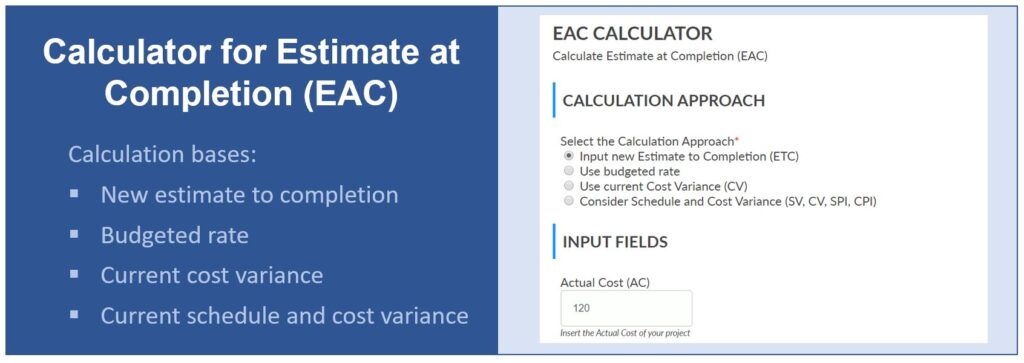You will need to calculate the Estimate at Completion on a regular basis when you are managing a project. At a minimum, you should do this when your cost controlling suggests that your cost or schedule might deviate from the plan or budget. You will also want to follow up if you feel, or team members tell you, that the project might not be able to meet the planned cost or performance.
If you are preparing for your PMP certification exam, you will also find this calculator useful, given that there are usually a few exam questions concerning the calculation and interpretation of the estimate at completion. Use this tool to re-calculate your own examples or simulate scenarios to get a better understanding of this subject matter.
- Different Approaches to Compute
the Estimate at Completion
- 1) Estimate at Completion (EAC) with bottom-up Estimate to Complete (ETC)
- 2) Estimate at Completion (EAC) with ETC at the Budgeted Rate
- 3) Estimate at Completion (EAC) with ETC based on Present Cost Variance (CV, CPI)
- 4) Estimate at Completion (EAC) considering Cost and Schedule Performance Indexes (CPI, SPI) and Variances
- Introduction to the EAC Calculator
- The EAC Calculator
- Afterword
Different Approaches to Compute the Estimate at Completion
The PMI’s Project Management Body of Knowledge (PMBOK®, 6th edition, p. 265) suggests the following 4 approaches.
1) Estimate at Completion (EAC) with bottom-up Estimate to Complete (ETC)
This approach implies that you add an Estimate to Complete, i.e. the amount of work or cost required to achieve completion of the project, to the actual cost at the current point in time. Usually, the ETC is calculated as a bottom-up figure which means that you would ask the project team to estimate the work required for their respective work packages.
However, in some cases, this number may be a top-down estimate, performed by subject matter experts or the project manager.
2) Estimate at Completion (EAC) with ETC at the Budgeted Rate
This approach reflects the assumption that the project will proceed with the planned and budgeted progress rate, regardless of the cost incurred and any previous deviations from the plan. This approach seems sensible when your project has been evolving in line with the plan so far and/or if you do not expect any impediments until completion.
3) Estimate at Completion (EAC) with ETC based on Present Cost Variance (CV, CPI)
If there have been any significant positive or negative deviations from the budget that are unlikely to be resolved during the progress of the project, you will want to extrapolate the cost development based on the current cost variance or cost performance index. This takes the deviations that have occurred into account when projecting the estimate at completion.
4) Estimate at Completion (EAC) considering Cost and Schedule Performance Indexes (CPI, SPI) and Variances
When deviations occur on the cost as well as on the schedule site, you will want to consider both observations in your forecast. This approach calculates the estimate at completion based on both cost variances and schedule variances (reflected as cost performance index and schedule performance index). It basically reflects the amount of additional or less work required to balance any schedule deviations, in addition to that amount arising from the cost variance.
Read our dedicated article to learn more about the EAC incl. formulas and examples.
Introduction to the EAC Calculator
As a first step, the calculator requires you to select one of the four abovementioned approaches. This selection determines which formula is used and which input parameters are required.
Input Parameters
| Input Parameter | Short Definition | Required for 1) Estimate at Completion (EAC) with bottom-up Estimate to Complete (ETC) | Required for 2) Estimate at Completion (EAC) with ETC at budgeted rate | Required for 3) Estimate at Completion (EAC) with ETC based on present CPI | Required for 4) Estimate at Completion (EAC) considering CPI and SPI |
| Actual Cost (AC) | cost incurred for the authorized work performed | Yes | Yes | Yes | Yes |
| Earned Value (EV) | part of the budget for the work that has been completed | No | Yes | Yes | Yes |
| Planned Value (PV) | Planned part of the budget for work that was planned to be completed | No | No | No | Yes |
| Budget at Completion (BAC) | The initial total budget of the project (before management reserve) | No | Yes | Yes | Yes |
| Estimate to Complete | A point-in-time estimate of how much work / cost will be required to complete the project | Yes | No | No | No |
The EAC Calculator
Choose the calculation approaches, as introduced in the previous section, and fill in the required input parameters to calculate your estimate at completion.
Afterword
We hope you have found this Estimate at Completion (EAC) Calculator useful. If you have any feedback or suggestions, feel free to let us know!
Make sure you also read our articles on Earned Value Management and project cost estimating where we introduce related techniques.

